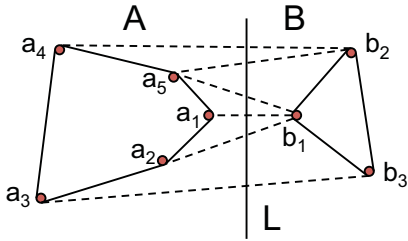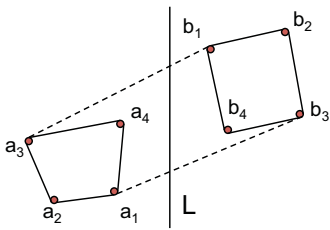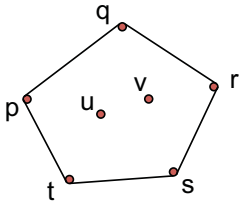Lecture 2: Divide and Conquer¶
约 473 个字 3 张图片 预计阅读时间 2 分钟 共被读过 次
Paradigm¶
- Given: A problem of size \(n\).
- Divide it into subproblems of size \(\frac{n}{b}\), where \(a \geq 1\), \(b > 1\).
- Solve each subproblem recursively.
- Combine solutions to form the overall solution.
Recurrence Relation:
$$
T(n) = a T\left(\frac{n}{b}\right) + [\text{work for merge}]
$$
Convex Hull¶
Problem Definition¶
- Input: \(n\) points in the plane:
$$
S = \left{ (x_i, y_i) \mid i = 1, 2, \ldots, n \right}
$$ - Assumptions: No two points share the same \(x\)- or \(y\)-coordinate; no three points are colinear.
- Output: Convex Hull \(\text{CH}(S)\), the smallest polygon containing all points in \(S\).
Brute Force Approach¶
- Test each line segment to determine if it is an edge of the convex hull:
- If all other points lie on one side of the segment, the segment is part of the convex hull.
- Complexity: \(O(n^3)\) (testing \(O(n^2)\) edges with \(O(n)\) checks per edge).
Divide and Conquer Approach¶
- Sort points by \(x\)-coordinate (\(O(n \log n)\)).
- Divide \(S\) into left half \(A\) and right half \(B\).
- Recursively compute \(\text{CH}(A)\) and \(\text{CH}(B)\).
- Merge the two convex hulls.
Merge Step¶
- Find Upper Tangent \((a_i, b_j)\) and Lower Tangent \((a_k, b_m)\).
- Link \(a_i \rightarrow b_j\), traverse down \(B\) to \(b_m\), link \(b_m \rightarrow a_k\), and return to \(a_i\).
Example:

- Upper Tangent: \((a_4, b_2)\).
- Lower Tangent: \((a_3, b_3)\).
- Merged Hull: \((a_4, b_2, b_3, a_3)\).
Finding Tangents¶
- Upper Tangent: Maximizes \(y(i, j)\), where \(y(i, j)\) is the \(y\)-coordinate of the intersection between the vertical separating line \(L\) and segment \((a_i, b_j)\).
- Algorithm:
1. Initialize \(i = 1\), \(j = 1\).
2. While \(y(i, j+1) > y(i, j)\) or \(y(i-1, j) > y(i, j)\):- If \(y(i, j+1) > y(i, j)\): \(j = j + 1 \mod q\).
- Else: \(i = i - 1 \mod p\).
3. Return \((a_i, b_j)\).
- Time Complexity:
$$
T(n) = 2 T\left(\frac{n}{2}\right) + \Theta(n) = \Theta(n \log n)
$$
Median Finding¶
Problem Definition¶
- Rank of \(x\): Number of elements \(\leq x\).
- Goal: Find element with rank \(\left\lfloor\frac{n+1}{2}\right\rfloor\) (lower median) or \(\left\lceil\frac{n+1}{2}\right\rceil\) (upper median).
Algorithm: SELECT¶
- Pick \(x \in S\) cleverly (median of medians).
- Partition \(S\) into \(B = \{y \in S \mid y < x\}\) and \(C = \{y \in S \mid y > x\}\).
- Recurse on \(B\) or \(C\) based on \(k = \text{rank}(x)\):
- If \(k = i\), return \(x\).
- If \(k > i\), return \(\text{SELECT}(B, i)\).
- If \(k < i\), return \(\text{SELECT}(C, i - k)\).
Median of Medians¶
- Arrange \(S\) into columns of size 5.
- Sort each column (linear time).
- Recursively compute the median of medians.
Recurrence:
$$
T(n) =
\begin{cases}
O(1), & \text{for } n \leq 140, \
T\left(\left\lceil\frac{n}{5}\right\rceil\right) + T\left(\frac{7n}{10} + 6\right) + \Theta(n), & \text{for } n > 140.
\end{cases}
$$
Proof Sketch:
$$
T(n) \leq cn \quad \text{(by induction, using } \frac{n}{5} + \frac{7n}{10} < n\text{)}.
$$
Appendix¶
Example: Tangent Identification¶

- Upper Tangent: \(a_3, b_1\).
- Lower Tangent: \(a_1, b_3\).
- Note: Tangents need not involve the highest/lowest points.
